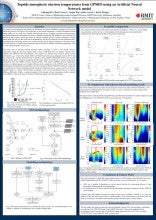Topside ionospheric plasma temperatures from GPSRO using an Artificial Neural Network model
Andong
Hu
SPACE Research Centre, RMIT University
Poster
This study is an investigation into whether the GPS Radio Occultation (GPSRO) technique can be used to obtain the electron (Te) and ion (Ti) temperature in the topside ionosphere. Currently, Incoherent Scatter Radars (ISRs) are one of the most reliable and long-term sources of topside ionospheric electron density and plasma temperature information. However, a shortfall of using the ISR databases is the relatively low number of ISR stations around the world. In contrast, GPSRO provides topside ionospheric electron density data from all over the world, but Te and Ti information is not directly detected. Previous researchers have investigated the relationship between the electron density and the plasma temperature, but these studies have not explicitly considered some parameters that are known to influence the plasma temperature; such as, solar and geomagnetic activity level.
This study uses an Artificial Neural Network (ANN) technique to create a new topside plasma temperature model that has been trained using 7 years of ISR data from two stations; Arecibo (low-latitude) and Millstone Hill (mid-latitude). This model was trained using electron density profile information (e.g., vertical scale height, HmF2 and NmF2) and solar and geomagnetic activity (F10.7 and Kp, respectively), and the model provides both the Te and Ti profiles. This modelled relationship between the electron density profile and the plasma temperature profiles thus allows the extraction of plasma temperature information from the GPSRO electron density profiles. This model’s GPSRO plasma temperature profiles are validated against out-of-sample ISR data, and a comparison of the GPSRO results versus the Thermosphere-Ionosphere-Electrodynamics General Circulation Model (TIEGCM) outputs is conducted. It is found that the plasma temperature profiles from the ANN had a relative accuracy of 95% in the low-latitude region (i.e., against Arecibo data), compared to 90% in the mid-latitude region (i.e., against Millstone Hill data). Finally, a statistical analysis of the diurnal plasma temperature profiles obtained from GPSRO are shown to agree well with the TIEGCM outputs in low-latitude regions.
This study uses an Artificial Neural Network (ANN) technique to create a new topside plasma temperature model that has been trained using 7 years of ISR data from two stations; Arecibo (low-latitude) and Millstone Hill (mid-latitude). This model was trained using electron density profile information (e.g., vertical scale height, HmF2 and NmF2) and solar and geomagnetic activity (F10.7 and Kp, respectively), and the model provides both the Te and Ti profiles. This modelled relationship between the electron density profile and the plasma temperature profiles thus allows the extraction of plasma temperature information from the GPSRO electron density profiles. This model’s GPSRO plasma temperature profiles are validated against out-of-sample ISR data, and a comparison of the GPSRO results versus the Thermosphere-Ionosphere-Electrodynamics General Circulation Model (TIEGCM) outputs is conducted. It is found that the plasma temperature profiles from the ANN had a relative accuracy of 95% in the low-latitude region (i.e., against Arecibo data), compared to 90% in the mid-latitude region (i.e., against Millstone Hill data). Finally, a statistical analysis of the diurnal plasma temperature profiles obtained from GPSRO are shown to agree well with the TIEGCM outputs in low-latitude regions.

Poster PDF
Abstract file